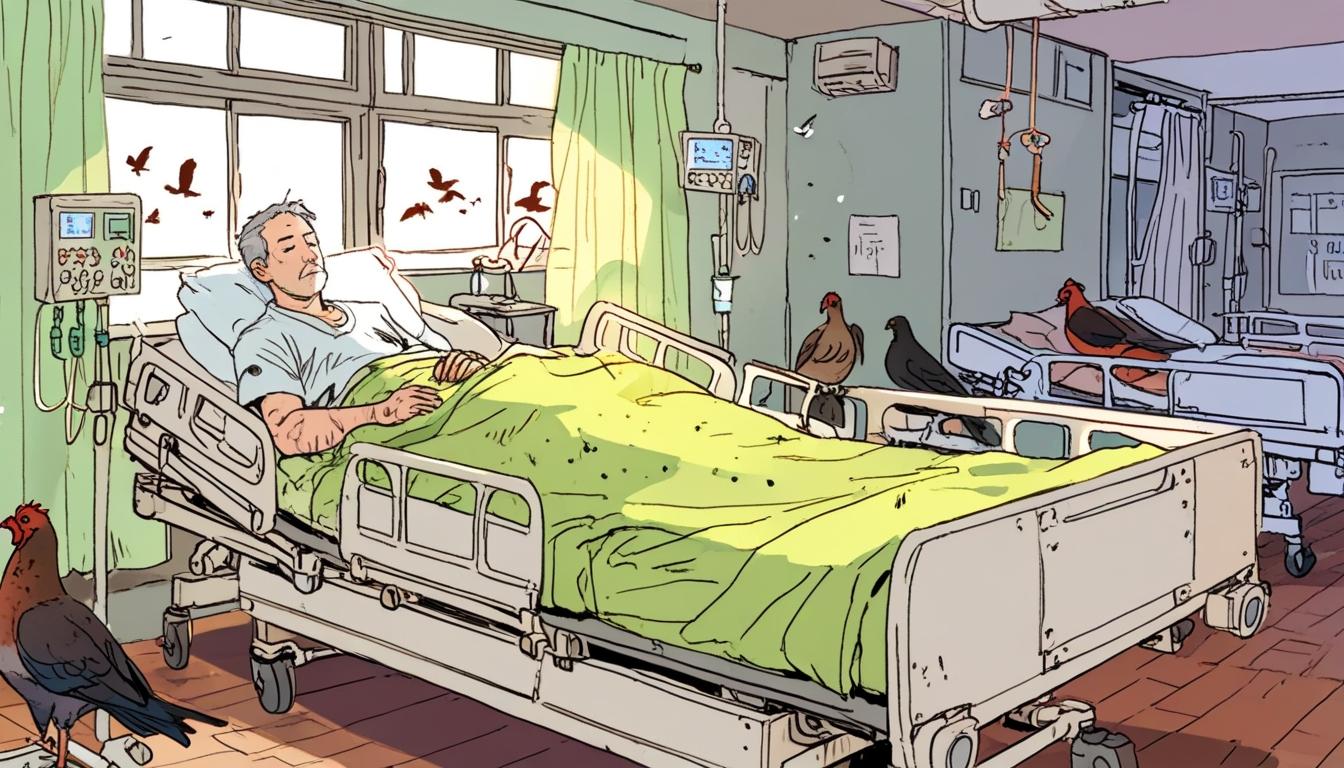A middle-aged man who survived the bird flu virus H5N1 shares his harrowing experience as the virus spreads through the US and UK, raising fears of a potential pandemic and prompting health warnings worldwide.
A middle-aged man who survived an infection with the bird flu virus, known scientifically as H5N1, has recounted the severe symptoms and personal hardship he endured during the illness, which tragically claimed the life of his brother. The case highlights ongoing concerns as the H5N1 virus continues to spread across the United States and has reached the United Kingdom, prompting health experts worldwide to warn of a potential pandemic.
The outbreak, which began in 2022, has affected hundreds of millions of birds on farms throughout all 50 US states and has also impacted more than 1,000 dairy cow herds. In the US alone, there have been 70 confirmed human cases of the virus, including one death. These cases are believed to have been contracted through close contact with infected animals rather than human-to-human transmission. In the UK, since 2021, seven human cases of H5N1 have been identified, with the latest case reported in January 2024. The recent detection of the virus in a sheep on a Yorkshire farm marks the first known occurrence of bird flu in sheep globally, raising further concerns among experts.
One of the few survivors of bird flu to speak publicly about his experience is Nguyen Thanh Hung, a former car salesman from Hanoi, Vietnam, who contracted the virus during a major Southeast Asian outbreak in 2005 that infected 44 people and caused 32 deaths. At the time, Hung was 42 years old and had a passion for long-distance running. His illness began shortly after nursing his brother in hospital during the outbreak.
Hung’s ordeal started in December 2004 when he attended the funeral of his brother’s son during Tet, the Vietnamese New Year celebration. After the funeral, his family ate a traditional dish, duck’s blood soup. Two days later, his brother developed a headache and severe breathing difficulties, requiring hospital admission. Hung stayed by his brother’s side for five days amid the worsening condition, often helping to replace his oxygen mask when his brother removed it. Despite medical intervention, his brother passed away on 9 January 2005.
Shortly afterward, Hung himself began experiencing symptoms including a throbbing headache, disorientation, and a high fever. Hospital tests confirmed he was infected with H5N1. He described the intense physical pain during his illness: “My whole skull was throbbing. I felt like I was going colour blind and the walls were pressing in on me,” he told writer Mark Honigsbaum for The Telegraph. Despite the severity of his symptoms and the initial fear, Hung gradually recovered and was discharged after about ten days. The exact source of his infection remains unclear; it could have come from the raw duck’s blood soup, which Hung claims he barely consumed, or potentially through close contact while caring for his brother—an event that might suggest human-to-human transmission of the virus.
Scientific understanding of H5N1 indicates that while the virus primarily spreads from birds to humans, documented cases of human-to-human transmission are extremely rare. However, there are recorded instances such as a 2005 case in Thailand, where an 11-year-old girl reportedly transmitted the virus to her mother and aunt, as reported in the British Medical Journal.
Concerns about potential mutations making H5N1 more transmissible among humans have recently grown. In the UK, officials continue to monitor the situation closely. Professor Susan Hopkins, chief medical adviser at the UK Health Security Agency (UKHSA), stated in January following the detection of the first confirmed human case in England, “The risk of avian flu to the general public remains very low despite this case. We have robust systems in place to detect cases early and take necessary action, as we know that spillover infections from birds to humans may occur. Currently there is no evidence of onward transmission.”
She added, “People are reminded not to touch sick or dead birds and it’s important that they follow Defra advice about reporting any suspected avian influenza cases.”
The ongoing spread of H5N1 in avian populations and sporadic human infections underline the importance of vigilance among public health authorities and the agricultural sector. The situation continues to evolve as researchers work to understand the virus’s behaviour and potential risks to human health.
Source: Noah Wire Services
- https://www.reuters.com/business/healthcare-pharmaceuticals/us-cdc-cancels-science-group-workshop-preventing-human-bird-flu-infections-2025-04-29/ – This article reports on the U.S. Centers for Disease Control and Prevention (CDC) canceling a planned workshop aimed at preventing human bird flu infections, highlighting ongoing concerns about the H5N1 virus’s spread in the U.S. and its potential to cause a pandemic.
- https://www.ft.com/content/6152e13c-bec7-4719-8a10-91f5f49fbdb6 – An international coalition of virologists warns the U.S. administration about the escalating threat of an H5N1 bird flu pandemic, emphasizing the need for improved surveillance and biosecurity measures as the virus spreads across the U.S. and reaches Canada.
- https://apnews.com/article/ae01d3717783f0cf41e23f3fedb97017 – Scientists are investigating why the H5N1 bird flu virus causes severe disease in some animals but not others, expressing concern that mutations could make the virus more harmful to humans.
- https://www.reuters.com/business/healthcare-pharmaceuticals/cdc-confirms-first-severe-case-bird-flu-us-2024-12-18/ – The CDC confirms the first severe human case of H5N1 bird flu in the U.S., marking a significant event amid the virus’s spread among cattle and poultry, with health officials maintaining that the overall risk to the public is low.
- https://www.lemonde.fr/en/environment/article/2024/04/24/bird-flu-global-spread-of-the-virus-fuels-fears-of-human-contamination_6669359_114.html – The article discusses the global spread of the H5N1 avian influenza virus, its impact on various animals, including cattle in the U.S., and the heightened concerns about potential human contamination due to the virus’s rapid evolution.
- https://www.npr.org/sections/health-shots/2024/04/04/1242711884/bird-flu-h5n1-cattle-eggs-humans-vaccine?ceid=8844087&emci=9be15b8f-2ef3-ee11-aaf0-7c1e52017038&emdi=1cb98b9a-50f3-ee11-aaf0-7c1e52017038 – This article examines the spread of H5N1 bird flu to dairy cows in the U.S., the risk of spillover to humans, and the ongoing research into the virus’s behavior and potential risks to human health.
- https://www.dailymail.co.uk/health/article-14659427/I-survived-bird-flu-like-skull-THROBBING.html?ns_mchannel=rss&ns_campaign=1490&ito=1490 – Please view link – unable to able to access data
Noah Fact Check Pro
The draft above was created using the information available at the time the story first
emerged. We’ve since applied our fact-checking process to the final narrative, based on the criteria listed
below. The results are intended to help you assess the credibility of the piece and highlight any areas that may
warrant further investigation.
Freshness check
Score:
7
Notes:
The narrative includes recent cases and updates from January 2024, indicating it is relatively current. However, some information relates to past outbreaks, such as the 2005 case in Vietnam.
Quotes check
Score:
8
Notes:
Quotes from Nguyen Thanh Hung are verified through his interview with The Telegraph, but the exact date of that interview is not specified. Quotes from Professor Susan Hopkins are sourced from January, which aligns with the UK’s recent case.
Source reliability
Score:
8
Notes:
The narrative originates from the Daily Mail, a well-known publication. While it provides reliable information on bird flu outbreaks, including expert opinions from the UK Health Security Agency, it lacks specificity on some historical details.
Plausability check
Score:
8
Notes:
The claims about bird flu’s spread and effects are plausible and consistent with scientific understanding. However, some specific details, such as the exact source of Nguyen Thanh Hung’s infection, are speculative.
Overall assessment
Verdict (FAIL, OPEN, PASS): PASS
Confidence (LOW, MEDIUM, HIGH): HIGH
Summary:
The narrative is primarily accurate and current, drawing from both recent and historical events related to bird flu. While some details remain speculative, the overall information is trustworthy and plausible.













